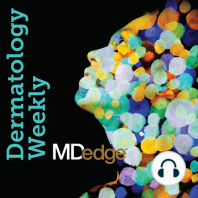26 min listen

Rosacea classification controversies; plus skin cancer chemoprevention, and coronary inflammation and psoriasis
Rosacea classification controversies; plus skin cancer chemoprevention, and coronary inflammation and psoriasis
ratings:
Length:
29 minutes
Released:
Aug 15, 2019
Format:
Podcast episode
Description
Rosacea diagnosis relies on clinical judgment. Dr. Vincent DeLeo talks to Dr. William James about rosacea classification and its controversies. Dr. James describes the evolution of rosacea classification systems and the need to define the clinical features of rosacea to improve patient care. “There is no gold-standard laboratory diagnosis for [rosacea],” Dr. James explains. “It’s really a diagnosis that’s made on clinical criteria, so those criteria I think should be well defined.” We also bring you the latest dermatology news and research. 1. Beyond sunscreen: Skin cancer preventive agents finding a role A growing list of skin cancer chemopreventive agents is expanding options for risk management. 2. Psoriasis patients on biologics show improved heart health Novel imaging biomarker identifies reduced coronary inflammation in psoriasis patients on biologics. 3. Dupilumab found effective for adolescents with moderate to severe atopic dermatitis The rates of skin infections also were higher in the placebo group, compared with the treatment groups. Things you will learn in this episode: There are three published rosacea classification systems based on clinical presentation, including the original classification schema introduced by the National Rosacea Society in 2002 and updated in 2018 as well as a similar classification system published by the global ROSacea COnsensus panel in 2017. The initial classification system included a list of primary and secondary features that were considered diagnostic of rosacea, but no standardized group of characteristics has been shown to be applicable in all cases of rosacea. The newer classification systems focus more on identifying phenotypic changes in rosacea patients rather than classifying subtypes of disease, as not every rosacea patient presents with a classic constellation of symptoms. Targeting individual symptoms of rosacea allows for more specific treatments based on a patient’s unique clinical presentation rather than designing therapies for broad subtypes. Despite advancements made in the newer classification systems, some of the definitions of primary features of classification still require more refinement; for instance, the classifications address flushing in rosacea as a very quick reaction, occurring within seconds to minutes of a trigger, but they do not address the prolonged nature of the redness, which is not as transient as in people who are simply embarrassed or overheated from exercise. Although it was included in the initial classification schema, granulomatous rosacea was eliminated in the newer classifications, likely because it does not share commonalities with traditional rosacea presentations. When diagnosing rosacea, it is important to consider other disease states that can lead to a red face and are in fact associated with diagnostic laboratory values or histopathologic appearances, such as systemic lupus, dermatomyositis, mastocytosis, carcinoid syndrome, polycythemia vera, and diabetes, as these conditions are more serious from a systemic standpoint. New treatment algorithms for rosacea focus on treating specific phenotypes rather than groups of symptoms, leading to more targeted therapies that can be used to treat individual patient presentations. Hosts: Elizabeth Mechcatie, Terry Rudd, Vincent A. DeLeo, MD (Keck School of Medicine of the University of Southern California, Los Angeles) Guest: William D. James, MD (University of Pennsylvania School of Medicine, Philadelphia) Show notes by: Alicia Sonners, Melissa Sears, Elizabeth Mechcatie You can find more of our podcasts at http://www.mdedge.com/podcasts Email the show: podcasts@mdedge.com Interact with us on Twitter: @MDedgeDerm
Released:
Aug 15, 2019
Format:
Podcast episode
Titles in the series (100)
Contact allergy to products with methylisothiazolinone; plus, topical options for hyperpigmentation, and thread lifts return: Household and personal care products are common sources of contact allergy in dermatology patients. Dr. Vincent DeLeo talks with Dr. Amber Atwater and Dr. Margo Reeder and about the epidemic of allergic contact dermatitis associated with... by Dermatology Weekly